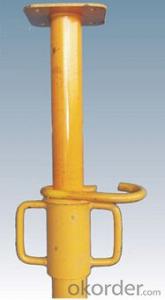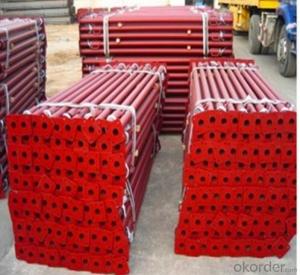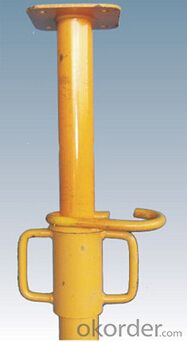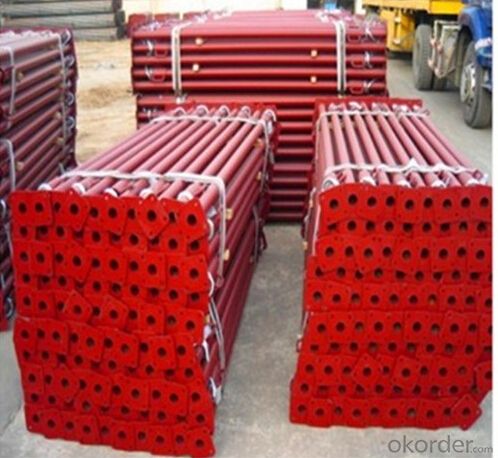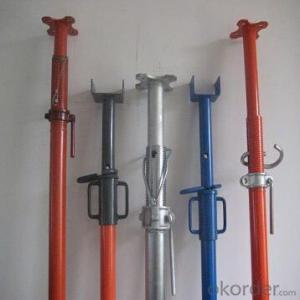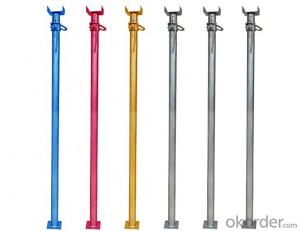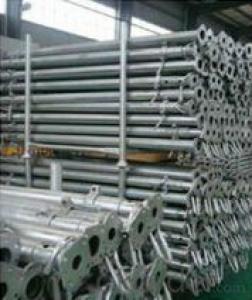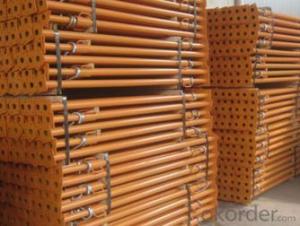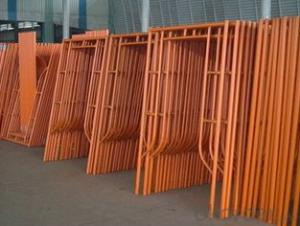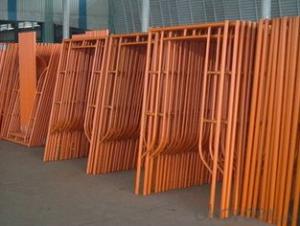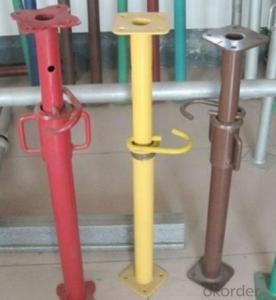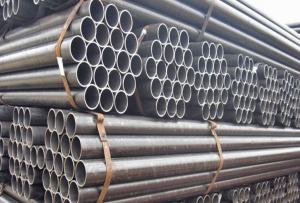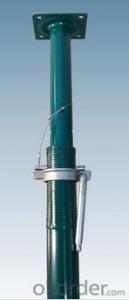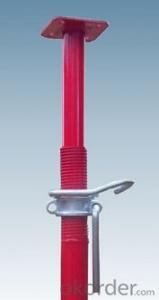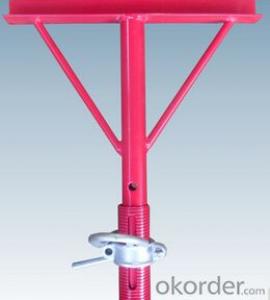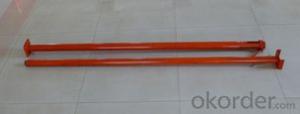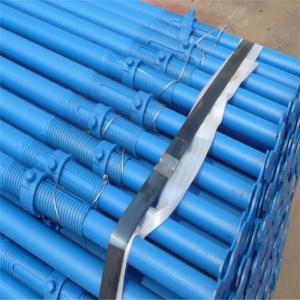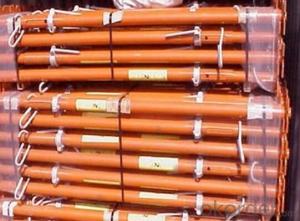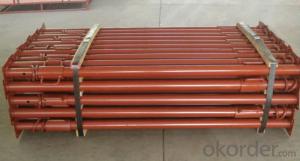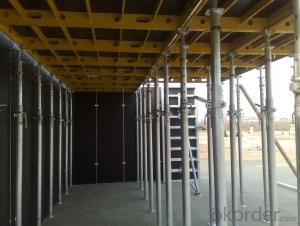Scaffolding pipe support system steel
- Loading Port:
- China Main Port
- Payment Terms:
- TT OR LC
- Min Order Qty:
- -
- Supply Capability:
- -
OKorder Service Pledge
Quality Product, Order Online Tracking, Timely Delivery
OKorder Financial Service
Credit Rating, Credit Services, Credit Purchasing
You Might Also Like
Quick Details
| Place of Origin: | Name: | ||||
| Adjustable Size: | Thickness: | Finishment: | |||
| MOQ: | Delivery Time: | Payment Term: | |||
| Business Type: | Color: | Location: |
Packaging & Delivery
| Packaging Detail: | In bundle or in bulk or as your request,normally in bulk can be loaded 1800-2500pcs for different size in one 20ft container. |
| Delivery Detail: | 10 to 30 days after order confirmation |
Specifications
construction props
1)Manufacturer 10 years ;
2)OEM offered,
3)Formwork,beam,concrete,slab support,
4)Promptly delivery.
| Name | construction props |
| Place of Origin | Guangzhou China |
| Brand name | Shuangma |
| Size | Ø40- Ø48/Ø48- Ø56 or as your request |
| Main Material | Q235, Q195 |
| Surface Treatment | High Protected Painted, Powder Coating, Electric Gavenized, Hot Dip Gavenized. |
| Color | Silver, red,orange |
| Certificate | SGS, |
| Service | OEM Service available |
| MOQ | 500pcs |
| Payment | T/T |
| Delivery Time | 10-30 days after confirmation |
| Packing | In bulk or steel pallet or as your request |
| Production capability | 200 tons per day |
- Q: What are the main considerations when using steel props in confined spaces?
- The main considerations when using steel props in confined spaces include ensuring proper ventilation to prevent the accumulation of hazardous gases, assessing the stability of the ground and surrounding structures, and implementing appropriate safety measures to prevent accidental collapse or injury. Additionally, it is crucial to regularly inspect the props for any signs of damage or wear and to have a clear plan for emergency evacuation in case of an unforeseen event.
- Q: What are the alternatives to steel props for temporary support?
- There are various options available as alternatives to steel props for temporary support in construction projects. Some commonly used alternatives are as follows: 1. Adjustable Props: These props are similar to steel props but are constructed using materials like aluminum or lightweight alloys. They offer a temporary support system that can be easily adjusted to different heights. Adjustable props are lightweight, facilitating easy handling and transportation. 2. Timber Props: Timber props, also referred to as wooden props, are extensively utilized for temporary support in construction. They are made from solid wood or engineered timber and provide a cost-effective substitute for steel props. Timber props are lightweight, easy to install, and can be easily cut to the desired length. 3. Acrow Props: Acrow props are a popular choice as an alternative to steel props. They consist of an inner tube, an outer tube, a threaded rod, and a base plate. Made from high-quality steel, acrow props offer adjustable support. They find common application in construction projects where temporary support is required. 4. Scaffolding: Scaffolding systems can also be employed as an alternative to steel props for temporary support. They provide a versatile and secure working platform that can be easily adjusted to different heights. Scaffolding systems are constructed using various materials like aluminum, steel, or composite materials. 5. Shoring Systems: Shoring systems are specifically designed to offer temporary support to structures during construction or repair work. These systems comprise vertical supports, horizontal beams, and adjustable struts. Shoring systems are commonly utilized in building construction, excavation works, and tunnel construction. 6. Hydraulic Jacks: Hydraulic jacks present another alternative to steel props for temporary support. They utilize hydraulic pressure to provide support to structures. These jacks are commonly employed in applications where heavy loads need to be lifted or temporarily supported. When selecting an alternative to steel props for temporary support, it is crucial to consider the specific requirements of the project, such as load-bearing capacity, adjustability, ease of installation, and cost-effectiveness.
- Q: I would like to ask the steel support line load is 420kn/m (design value), 20 meters deep foundation pit, steel support diameter of 609, wall thickness of 16mm
- Of course you can't do this! The worker is right! You might as well ask someone to give a sketch and see how it can be added
- Q: Do steel props comply with building codes and regulations?
- Yes, steel props comply with building codes and regulations. They are commonly used in construction projects as temporary supports for various structural elements, such as floors, walls, and beams. Steel props are designed and manufactured to meet specific load-bearing requirements and safety standards outlined in building codes and regulations. They undergo rigorous testing and are certified to ensure their reliability and compliance with these standards.
- Q: Can steel props be used in residential construction projects?
- Yes, steel props can be used in residential construction projects. Steel props are adjustable support systems that provide temporary structural support during construction. They are commonly used for propping up ceilings, walls, and beams, ensuring stability and safety during the construction process. Steel props are versatile, durable, and can be easily adjusted to fit various heights and load requirements, making them suitable for use in residential construction projects.
- Q: What are the common certifications and standards for steel props?
- Some common certifications and standards for steel props include the British Standard (BS 4074), European Standard (EN 1065), and the American National Standard (ANSI/ASSE A10.9). These certifications ensure that steel props meet certain quality and safety requirements, such as load capacity and stability, making them suitable for temporary support in construction projects.
- Q: How do you ensure proper alignment of steel props in a row?
- To ensure proper alignment of steel props in a row, there are a few steps that can be followed: 1. Start by marking the positions where the steel props will be placed. This can be done by measuring and marking the required spacing between each prop along the row. 2. Use a string line or a laser level to create a straight reference line. This line will serve as a guide to ensure that the props are aligned properly. Place the line or level at the marked positions of the props. 3. Position the first steel prop at the marked spot on the reference line. Make sure it is plumb and level. Adjust the prop as necessary to achieve proper alignment. 4. Once the first prop is aligned, move on to the next one. Use a spirit level or a plumb bob to ensure that each subsequent prop is perfectly vertical and aligned with the reference line. Adjust the props accordingly. 5. Repeat this process for all the remaining props in the row, ensuring that each one is aligned and spaced correctly. 6. Double-check the alignment of all the props after they have been placed. This can be done by using a string line or a laser level to check if they are all in line with the reference line and properly aligned with each other. 7. Finally, secure the props in place using appropriate locking mechanisms or braces to prevent any movement or misalignment. By following these steps, you can ensure proper alignment of steel props in a row, which is crucial for the stability and safety of the structure being supported.
- Q: Can steel props be used to support temporary stages or platforms?
- Yes, steel props can be used to support temporary stages or platforms. Steel props, also known as adjustable steel props or steel shores, are sturdy and reliable support systems commonly used in construction and temporary structures. They are designed to provide vertical support and can be adjusted to different heights, making them suitable for various applications, including supporting temporary stages or platforms. Steel props are easy to install, durable, and can bear heavy loads, making them a preferred choice for ensuring the stability and safety of temporary structures.
- Q: Can steel props be used in pipeline construction?
- Yes, steel props can be used in pipeline construction. Steel is a strong and durable material that can provide the necessary support and stability required for pipeline installations.
- Q: How long is the lifespan of a steel prop?
- The lifespan of a steel prop can vary depending on various factors such as usage, maintenance, and environmental conditions. However, steel props are known for their durability and can typically last for several years, especially when properly cared for and used within their specified load limits.
Send your message to us
Scaffolding pipe support system steel
- Loading Port:
- China Main Port
- Payment Terms:
- TT OR LC
- Min Order Qty:
- -
- Supply Capability:
- -
OKorder Service Pledge
Quality Product, Order Online Tracking, Timely Delivery
OKorder Financial Service
Credit Rating, Credit Services, Credit Purchasing
Similar products
Hot products
Hot Searches
Related keywords
